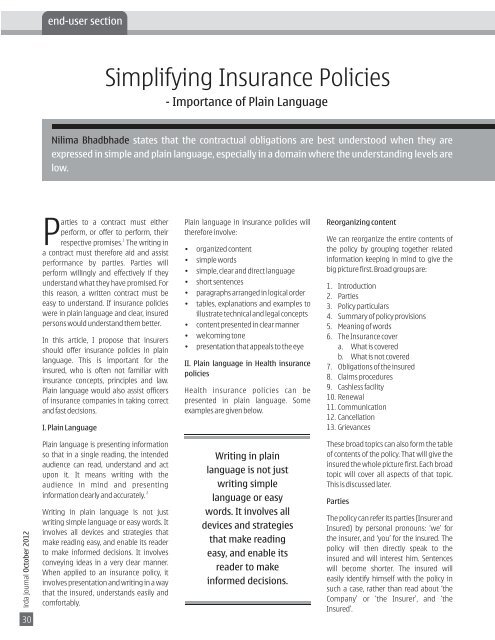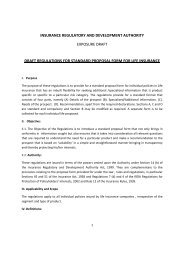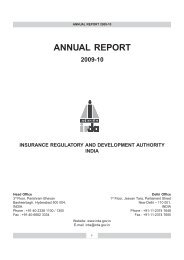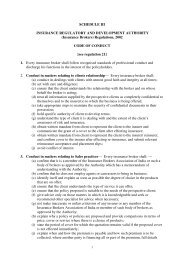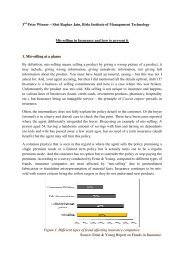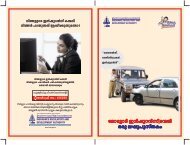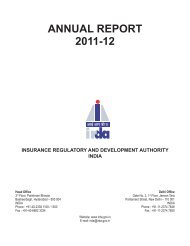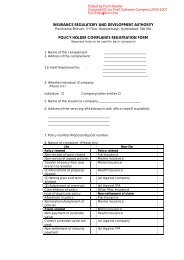'ÃÄ ÃflßĸÄ⧠â¢Ä±âU Ãflâ§Äâ ŽËÄÃÅâ§âUÃ¡Ä - IRDA
'ÃÄ ÃflßĸÄ⧠â¢Ä±âU Ãflâ§Äâ ŽËÄÃÅâ§âUÃ¡Ä - IRDA
'ÃÄ ÃflßĸÄ⧠â¢Ä±âU Ãflâ§Äâ ŽËÄÃÅâ§âUÃ¡Ä - IRDA
You also want an ePaper? Increase the reach of your titles
YUMPU automatically turns print PDFs into web optimized ePapers that Google loves.
end-user sectionSimplifying Insurance Policies- Importance of Plain LanguageNilima Bhadbhade states that the contractual obligations are best understood when they areexpressed in simple and plain language, especially in a domain where the understanding levels arelow.Parties to a contract must eitherperform, or offer to perform, their1respective promises. The writing ina contract must therefore aid and assistperformance by parties. Parties willperform willingly and effectively if theyunderstand what they have promised. Forthis reason, a written contract must beeasy to understand. If insurance policieswere in plain language and clear, insuredpersons would understand them better.In this article, I propose that insurersshould offer insurance policies in plainlanguage. This is important for theinsured, who is often not familiar withinsurance concepts, principles and law.Plain language would also assist officersof insurance companies in taking correctand fast decisions.I. Plain LanguagePlain language in insurance policies willtherefore involve:• organized content• simple words• simple, clear and direct language• short sentences• paragraphs arranged in logical order• tables, explanations and examples toillustrate technical and legal concepts• content presented in clear manner• welcoming tone• presentation that appeals to the eyeII. Plain language in Health insurancepoliciesHealth insurance policies can bepresented in plain language. Someexamples are given below.Reorganizing contentWe can reorganize the entire contents ofthe policy by grouping together relatedinformation keeping in mind to give thebig picture first. Broad groups are:1. Introduction2. Parties3. Policy particulars4. Summary of policy provisions5. Meaning of words6. The Insurance covera. What is coveredb. What is not covered7. Obligations of the insured8. Claims procedures9. Cashless facility10. Renewal11. Communication12. Cancellation13. Grievancesirda journal October 201230Plain language is presenting informationso that in a single reading, the intendedaudience can read, understand and actupon it. It means writing with theaudience in mind and presenting2information clearly and accurately.Writing in plain language is not justwriting simple language or easy words. Itinvolves all devices and strategies thatmake reading easy, and enable its readerto make informed decisions. It involvesconveying ideas in a very clear manner.When applied to an insurance policy, itinvolves presentation and writing in a waythat the insured, understands easily andcomfortably.Writing in plainlanguage is not justwriting simplelanguage or easywords. It involves alldevices and strategiesthat make readingeasy, and enable itsreader to makeinformed decisions.These broad topics can also form the tableof contents of the policy. That will give theinsured the whole picture first. Each broadtopic will cover all aspects of that topic.This is discussed later.PartiesThe policy can refer its parties (Insurer andInsured) by personal pronouns: ‘we’ forthe insurer, and ‘you’ for the insured. Thepolicy will then directly speak to theinsured and will interest him. Sentenceswill become shorter. The insured willeasily identify himself with the policy insuch a case, rather than read about ‘theCompany’ or ‘the Insurer’, and ‘theInsured’.


